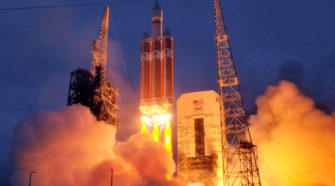The Pi Day of the Century
If you like numbers, you will love March 14, 2015. When written as a numerical date, it’s 3/14/15, corresponding to the first five digits of pi (3.1415) — a once-in-a-century coincidence! Pi Day, which would have been the 136th birthday of Albert Einstein, is a great excuse to eat pie, and to appreciate how important …
Astronomical serendipity
Since 1594, when Johannes Kepler predicted that there should be a planet between Mars and Jupiter, astronomers had been searching for that “missing planet.” When Giuseppe Piazzi discovered Ceres in 1801, the scientific world thought that he had ended the search. Then Ceres disappeared from sight, only to be recovered one year later. Astronomers breathed …
Crews named for future ISS missions
NASA and its International Space Station partners have announced the crew members for three upcoming missions to the space station during 2016 and 2017. Expedition 48: Jeff Williams, NASA Alexey Ovchinin, Roscosmos Oleg Skripochka, Roscosmos Kate Rubins, NASA Anatoly Ivanishin, Roscosmos Takuya Onishi, JAXA Expedition 49: Anatoly Ivanishin, Roscosmos Kate Rubins, NASA Takuya Onishi, JAXA …
ESA experimental IXV spaceplane completes research flight
An experimental vehicle to develop an autonomous European reentry capability has completed its mission. ESA’s Intermediate eXperimental Vehicle flew a flawless reentry and splashed down in the Pacific Ocean just west of the Galapagos islands. The IXV spaceplane lifted off at 13:40 GMT (10:40 local time) on 11 February from Europe’s Spaceport in Kourou, French …
Orion spacecraft performs nearly flawlessly on first test flight
NASA marked a major milestone on its journey to Mars as the Orion spacecraft completed its first voyage to space on Dec. 5, 2014, traveling farther than any spacecraft designed for astronauts has been in more than 40 years. Orion blazed into the morning sky at 7:05 a.m. EST, lifting off from Space Launch Complex …
NASA Spinoff 2015: There’s more space in your life than you think
NASA technologies are being used to locate underground water in some of the driest places on the Earth, build quieter and more fuel-efficient airplanes, and create shock absorbers that brace buildings in earthquakes. The 2015 edition of NASA’s annual Spinoff publication highlights these and other technologies whose origins lie in space exploration, but now have …






